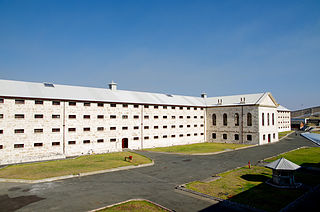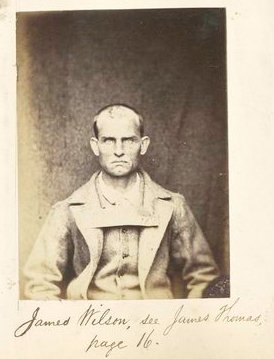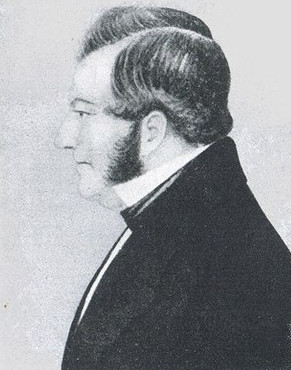Related Research Articles

Fremantle is a port city in Western Australia located at the mouth of the Swan River in the metropolitan area of Perth, the state capital. Fremantle Harbour serves as the port of Perth. The Western Australian vernacular diminutive for Fremantle is Freo.

The Catalpa rescue was the escape, on 17–19 April 1876, of six Irish Fenian prisoners from the Convict Establishment, a British penal colony in Western Australia. They were taken on the convict ship Hougoumont to Fremantle, Western Australia, arriving 9 January 1868. In 1869, pardons had been issued to many of the imprisoned Fenians. Another round of pardons was issued in 1871, after which only a small group of "military" Fenians remained in Western Australia's penal system.
City of Palaces may refer to:

Joseph Bolitho Johns, better known as Moondyne Joe, was an English convict and Western Australia's best-known bushranger. Born into poor and relatively difficult circumstances, he became something of a petty criminal robber with a strong sense of self-determination. He is remembered as a person who had escaped multiple times from prison.

Fremantle Prison, sometimes referred to as Fremantle Gaol or Fremantle Jail, is a former Australian prison and World Heritage Site in Fremantle, Western Australia. The site includes the prison cellblocks, gatehouse, perimeter walls, cottages, and tunnels. It was initially used for convicts transported from Britain, but was transferred to the colonial government in 1886 for use for locally-sentenced prisoners. Royal Commissions were held in 1898 and 1911, and instigated some reform to the prison system, but significant changes did not begin until the 1960s. The government department in charge of the prison underwent several reorganisations in the 1970s and 1980s, but the culture of Fremantle Prison was resistant to change. Growing prisoner discontent culminated in a 1988 riot with guards taken hostage, and a fire that caused $1.8 million worth of damage. The prison closed in 1991, replaced by the new maximum-security Casuarina Prison.

North Fremantle is a suburb of Perth, Western Australia, located within the City of Fremantle, a local government area of the state. Its postcode is 6159.

The convict era of Western Australia was the period during which Western Australia was a penal colony of the British Empire. Although it received small numbers of juvenile offenders from 1842, it was not formally constituted as a penal colony until 1849. Between 1850 and 1868, 9,721 convicts were transported to Western Australia on 43 convict ship voyages. Transportation ceased in 1868, but it was many years until the colony ceased to have any convicts in its care.

Hougoumont was the last convict ship to transport convicts to Australia.
William Hammond was a barque used to transport convicts to Western Australia.
General Godwin was a convict ship that transported fifteen convicts from Calcutta, India to Fremantle, Western Australia in 1854. It arrived in Fremantle on 28 March 1854. The fifteen convicts were all soldiers who had been convicted by court-martial and sentenced to transportation. In addition to the convicts, there were thirteen passengers on board.
Guide was a convict ship that transported six convicts from Calcutta, India to Fremantle, Western Australia in 1855. It arrived in Fremantle on 9 January 1855. The six convicts were all soldiers who had been convicted by court-martial and sentenced to transportation. In addition to the convicts, there were 16 passengers on board.
Scindian is widely considered the first convict ship to transport convicts to Western Australia. She was launched in 1844 and sank in 1880.

The Fremantle Arts Centre is a historic building complex on Ord Street in Fremantle, Western Australia.

The Lynton Convict Hiring Depot (1853–1857) was the first convict depot north of Fremantle, Western Australia. It was established on 22 May 1853 with the arrival of the 173 ton brigantine Leander, which transferred 60 ticket-of-leave convicts and Pensioner Guards that had arrived at Fremantle on the Pyrenees on 1 May. It was established to supply labour to the Geraldine Lead Mine, 64 kilometres north of the site on the Murchison River, and to local settlers. The depot was closed by order of Governor Kennedy on 3 January 1857 due to the high cost to the government of its maintenance.

The City of Fremantle is a local government area in the south of Perth, Western Australia. The City covers an area of 19.0 square kilometres (7.3 sq mi), and lies about 19 kilometres (12 mi) southwest of the Perth central business district.
Edward Lombe was a merchantman and passenger three-masted barque built in 1828 by Thomas Brodrick, of Whitby, England.

The Pensioner Guards were English military personnel who served on convict transportation ships en route to the Swan River Colony between 1850 and 1868, and were given employment and grants of land on arrival. Their initial employment lasted for six months, or the duration of the voyage, whichever was the longer time. After this they became "pensioners" and had to serve 12 days per year as well as whenever called upon. They paraded annually in Perth at the Pensioner Barracks. Part of their purpose was to fulfil a promise by the British government to send free settlers to the colony to dilute the convicts, and to maintain law and order in the colony.

Daniel Scott was a Western Australian harbour-master. Originally from Liverpool, England, he moved to the newly established Swan River Colony in 1829. Scott was the first chair of the Fremantle Town Trust in 1848. In addition to his civic and harbour duties, he was involved with launching a number of enterprises in early Western Australia, including the first whaling business, the first ship builders, and a lead mining business.
The history of Fremantle Prison, a former Australian prison in Fremantle, Western Australia, extends from its construction as a prison for convicts, using convict labour, in the 1850s, through to its modern-day usage as a tourist attraction. The design for Fremantle Prison was based on the Pentonville Prison in Britain, and it would be the longest, tallest prison cell block in the southern hemisphere. Construction began in 1851, and was completed by the end of 1859. The prison was transferred to the colonial government in 1886 for use for locally sentenced prisoners. Following a Royal Commission held in 1898−99, some changes were made to Fremantle Prison, including knocking down the inner wall between two cells, introducing a prisoner classification system, and constructing internal walls in the main block to create four separate divisions. A new cell block, New Division, was completed in 1907 and occupied in 1908.

The architecture of Fremantle Prison includes the six-hectare (15-acre) site of the former prison on The Terrace, Fremantle, in Western Australia. Limestone was quarried on-site during construction, and the south-western corner and eastern portion of the site are at a considerably higher ground level. The Fremantle Prison site includes the prison cell blocks, gatehouse, perimeter walls, cottages, tunnels, and related infrastructure.
References
- "Western Australian Convicts – City of Palaces 1857" . Retrieved 17 February 2006.